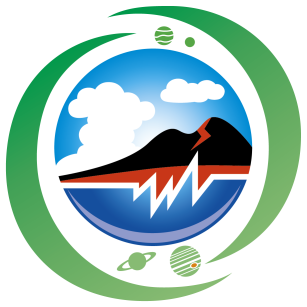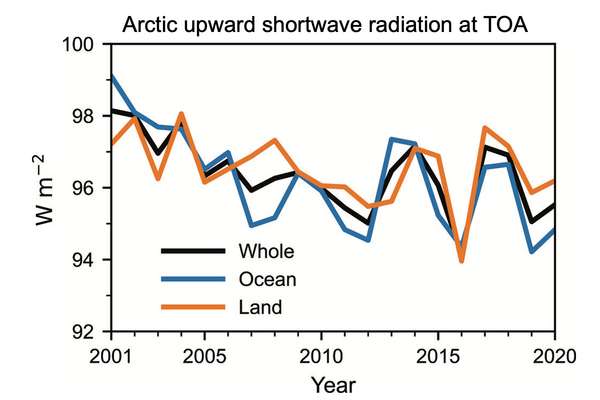Topics 2025.05.16
Interannual variation in upward shortwave radiation at top-of-atmosphere over the Arctic
Figure 1. Interannual variation in annual mean upward shortwave radiation at top-of-atmosphere (TOA) over the Arctic. (Modified figure from Amma and Hayasaka 2023)
The earth reflects some of the incoming energy from the sun and absorbs others. The energy is an important factor in determining the earth's climate. The energy emitted by the sun is shortwave radiation (solar radiation). The shortwave radiation absorbed by the earth is determined by the downward (incoming from the sun) and upward (reflected by the earth) shortwave radiation at the top-of-atmosphere (TOA). This study focuses on the upward shortwave radiation at TOA. The upward shortwave radiation at TOA is affected by the atmosphere (e.g., clouds, aerosols) and surface (e.g., sea ice, snow, vegetation).
In the Arctic, there have been significant climate changes, such as sea ice and snow cover retreats. In the Arctic, how does the upward shortwave radiation at TOA change? Sea ice and snow cover have high reflectance, and changes in the sea ice and snow cover affect the upward shortwave radiation at TOA. In addition, clouds also affect the upward shortwave radiation at TOA. In the Arctic, the seasonal variation of incoming shortwave radiation is large, and the effect of changes in sea ice, snow cover, and clouds on the upward shortwave radiation at TOA may differ from month to month. Therefore, we investigated the interannual variation in the monthly upward shortwave radiation at TOA over the Arctic and its factors. Using satellite observation data, we analyzed the upward shortwave radiation at TOA from 2001 to 2020.
Figure 1 shows the interannual variation in the annual mean upward shortwave radiation at TOA over the Arctic. The upward shortwave radiation over the whole Arctic shows a decreasing trend from 2001 to 2012 and no trend after 2012. After 2012, it shows a large interannual variation. Over ocean and land in the Arctic, the upward shortwave radiation also shows a decreasing trend from 2001 to 2012 and a large interannual variation after 2012.
Figure 2 shows the monthly anomalies of the upward shortwave radiation at TOA over ocean and land. The monthly anomalies represent the deviation from the mean value of the analysis period for each month. In other words, a large absolute value indicates a large change. The upward shortwave radiation at TOA shows a large change in June and July over ocean and from May to July over land. Analysis of variations in sea ice, snow cover, and cloud properties suggests that the interannual variations in the upward shortwave radiation at TOA are associated with sea ice cover in June and July for ocean, and snow cover in May and June and cloud properties in June and July for land.
Figure 2. Monthly anomalies of upward shortwave radiation at top-of-atmosphere over ocean and land in the Arctic. (Modified figure from Amma and Hayasaka 2023)
This study shows that the interannual variation in upward shortwave radiation at TOA is related to sea ice and snow cover in spring and summer and land clouds in summer. Detailed analysis of other regions is needed regarding global mean shortwave radiation variations.
This article is based on Amma and Hayasaka (2023) and summarizes the content of Amma and Hayasaka (2023).
Reference:
Amma, M. and T. Hayasaka, 2023: Interannual variation in top-of-atmosphere upward shortwave flux over the Arctic related to sea ice, snow cover, and land cloud cover in spring and summer, J. Climate, 36, 5163-5178, https://doi.org/10.1175/JCLI-D-22-0440.1
Michinari Amma
Former Research Fellow (Currently affiliated with the University of Michigan)
Radiation and Climate Physics Group, Center for Atmospheric and Oceanic Studies


